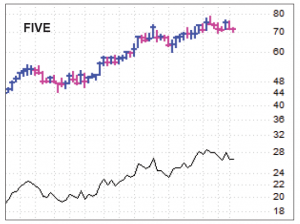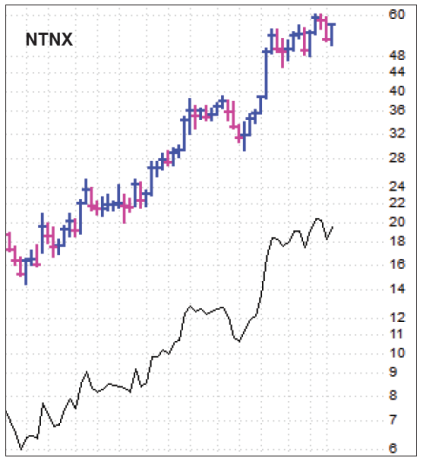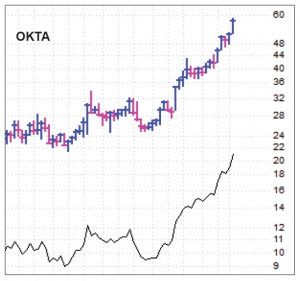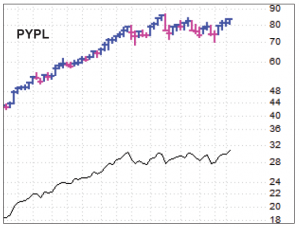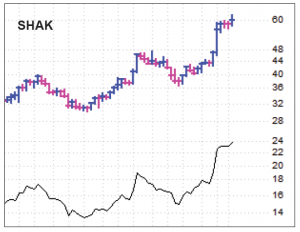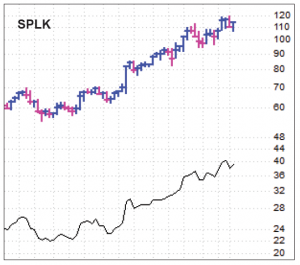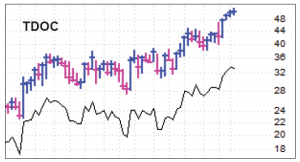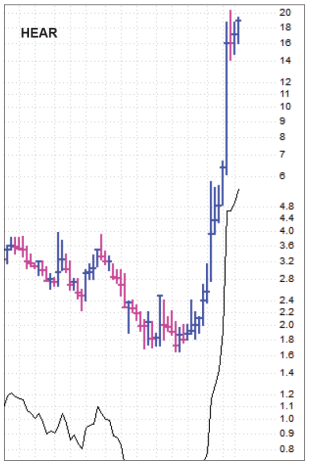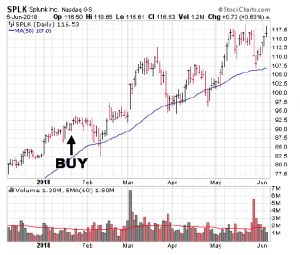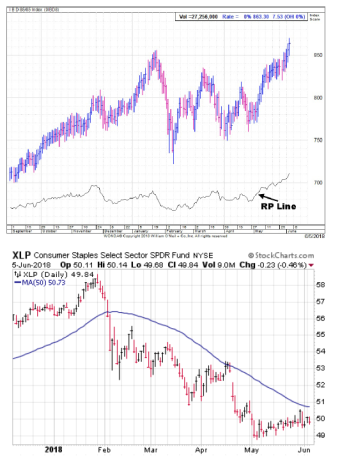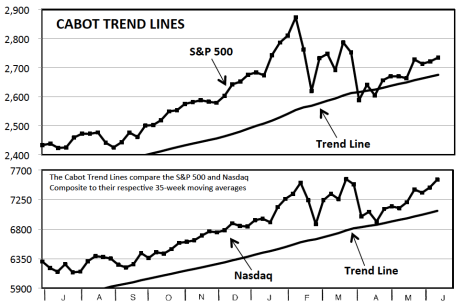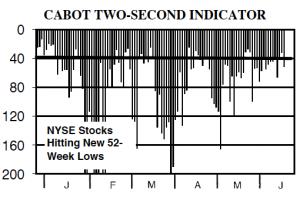Wide swaths of the market are still in no man’s land, including a handful of major indexes. But the growth areas of the market are looking great, with individual stocks, the Nasdaq and small-cap indexes hitting new highs.
Bottom line, while the picture isn’t perfect, there’s no question the evidence has improved enough to continue extending our line. In the Model Portfolio, we’re adding one familiar name tonight, bringing our cash position down to 20%, and are looking at more potential buys in the days ahead.
In addition to reviewing all our stocks, in tonight’s issue we also talk a bit about surviving shakeouts, something that has been (and will likely continue to) be key as the bull market progresses.
Cabot Growth Investor 1395
[premium_html_toc post_id="151345"]
Primary Evidence Looks Great
For large swaths of the market, the correction that began in late January is still hanging around. The S&P 500, for instance, has made up less than two-thirds of its 2018 decline and is still nearly 4% off its high. The Dow Industrials have made up less than half of their 2018 decline (5.7% off its peak) and the NYSE Composite is in even worse shape, 6.5% from its summit. Transportation, industrial, financial, health care and staples are mostly stuck in the mud.
But the growth-oriented areas of the market look great! Indeed, the S&P 600 SmallCap Index was the first to return to new highs during this rally (in early May!), and the Nasdaq followed its lead this week. Just as good from our point of view, the IBD 85-85 Index has also moved out to virgin turf (see page 7 for more).
As you know if you’ve been reading us for a while, these divergent environments aren’t our favorites. When investors are rowing in different directions, the risk of either a broad-based retreat (the weak areas pull down the strong ones) or a sharp bout of rotation (profit taking in leaders, buying the laggards) is higher than normal.
However, we’ve been writing all year that the market’s secondary evidence, while good to be aware of, isn’t something to trade off of. Today, the divergences above (as well as some other indicators like sentiment, which has turned bubbly during the past couple of weeks) are a bit worrisome. But the market’s primary evidence looks great, and that’s always where we place our emphasis.
Specifically, both of our trend-following indicators are still bullish, and not only are growth stocks strong, but a ton of them have recently emerged from multi-month consolidations. There are never any sure things, but seeing growth-oriented indexes hit new highs and growth stocks themselves bust out of consolidations (with sterling fundamentals, too) bodes well.
Long story short: We’re optimistic. Given the market’s latest push higher, we’re putting a little more money to work in tonight’s issue, and aiming to do further buying as opportunities present themselves.
[highlight_box]WHAT TO DO NOW: Do a little buying. In the Model Portfolio, we’re buying Alibaba (BABA), which has just broken out. That will leave us with 20% in cash, some of which we’re aiming to put to work in the days ahead.[/highlight_box]
Model Portfolio Update
It’s been a tedious first few months of the year for the market, but we’ve been pleased with how growth stocks have acted through much of the sloppiness. Sure, some got hit, but of those, the majority quickly found support and have ratcheted higher.
And now the bulls are starting to flex their muscles, especially when it comes to growth stocks, which is what we’ve been watching for since the initial thrust higher in early May. In the Model Portfolio, we’re adding Alibaba tonight, which will bring our cash position down to 20%.
That doesn’t mean it will all be smooth sailing going forward—our goal, as always, is to be in the market’s leading stocks. With two earnings reports out tonight (FIVE and OKTA) and plenty of crosscurrents, we’ll be watching our current stocks for any signs of fading sponsorship, while keeping an eye on new leadership that’s worth jumping on to.
Current Recommendations
BUY—Alibaba (BABA 208)—We made good money with BABA last year, but were shaken out during the stock’s long stale period; shares made no net progress from mid-August through mid-April (eight months). But the firm’s Q1 earnings report has reignited the stock’s longer-term advance, and as the stock has followed-through on the upside, we’re getting back in. The story remains the same, of course, and one thing we remain amazed with is Alibaba’s lightning-fast revenue growth (up 61% in local currency terms in Q1) despite its size (nearly $38 billion in revenue during the past year). Earnings are growing a bit slower than revenues as the company invests in its business and buys pieces in a ton of ancillary businesses, the latest being a 10% stake in ZTO Express for $1.4 billion, an outfit that could be the FedEx of China. While the stock’s original breakout was back in April of last year, we think BABA is still in the middle innings of its run. We’re buying some tonight.
HOLD—Five Below (FIVE 81)—From the third trading day of January through the end of last week, FIVE made no net progress and had plenty of ups and downs. Still, while not pleasant, shares didn’t do anything wrong, and they’ve been goosed this week by some positive analyst commentary—JP Morgan’s analyst thinks Five Below’s long-term forecast for 2,500 stores (already four times the store count at the end of last year) looks conservative, and he sees little reason why management’s 20%-plus annual earnings growth outlook can’t be achieved. Shares have been strong so far this week, and just going with the evidence, FIVE looks like a good buy—we’re optimistic the five-month rest period formed a sturdy foundation for a resumption of the stock’s major uptrend that kicked off last November. That said, the Q1 report is due out tonight, so we’ll stay on Hold and see how the stock reacts; barring a meltdown, our goal is to go back to Buy soon.
BUY—Grubhub (GRUB 108)—GRUB has shown some life during the past week, though sellers have shown up twice as the stock has tried to move to new highs. There’s been no obvious news to account for the recent uptick (the last press release was in early May regarding its deal with Jack in the Box), and we wouldn’t be shocked to see shares zigzag a bit from here. But bigger picture, we’re impressed that GRUB corrected just 20% from high to low during the past few months after more than doubling from November through March. Obviously, it’s not the first inning of the stock’s overall run, but given that its advance began “only” seven months ago and the company’s huge potential as takeout ordering goes online en masse, we think GRUB’s path of least resistance is up. Expect volatility, but we’re OK buying some here if you’re not yet in. We’re considering buying a few shares back (we have just a small position) if we see a decent entry point.
BUY—Nutanix (NTNX 56)—NTNX has done a decent job of fighting back from its two-day, post-earnings selloff; overall, shares have etched a couple of higher highs and higher lows since its massive-volume blastoff in early March, which is normal action and, all else equal, should lead to higher prices.Nutanix’s story can give you a bit of an ice cream headache, but we think its leading hyperconverged infrastructure software (billings for which rose a whopping 67% in Q1) are the next big thing when it comes to IT infrastructure spending. Indeed, the company has already attracted 9,690 customers (including 63 of the Forbes Global 100), including 820 new customers in Q1 alone. Back to the stock, a drop into the high 40s would be a yellow flag, but right now, we continue to think the next big move is up. We’ll stay on Buy.
BUY—Okta (OKTA 54)—OKTA is the second of two stocks we have that will report earnings tonight; analysts are looking for revenues to rise 49% and a loss of 16 cents per share, but obviously the outlook and many sub-metrics (customers, cash flow, etc.) will also be key. The stock has been incredibly strong all year, though it has taken a pre-earnings hit on a valuation-based downgrade earlier this week. A total collapse on earnings (down to 45 or so) would tell us the stock’s uptrend has cracked, but barring that, we’re optimistic that OKTA just kicked off a sustained advance in February and that its cloud-based identity solutions for enterprises have big growth potential. We’ll stick with our Buy rating, but will be on the horn if we have any changes following the report.
HOLD—PayPal (PYPL 85)—Ever since PYPL got nailed in early May on reports that Amazon was entering the payment field, the stock has been a sterling performer, steadily rallying back toward its all-time highs from January. As we wrote in last week’s update, the company nudged up its three- to five-year outlook and is now looking for 17% to 18% annual revenue growth with expanding margins and healthy free cash flow that it’ll use to invest in its business, buy back shares (the Q1 share count was down 1.5% from the prior year) and engage in some M&A—it just bought Jetlore, for instance, an AI-powered predictive platform for retailers that will boost PayPal’s marketing solutions segment. We do like the overall action and if you really want in, we’re not dead set against buying some here. But officially we’re going to stick with a Hold rating for now, mostly because the stock has come straight up from its lows and could easily rest for a while near the top of its launching pad.
HOLD—Proofpoint (PFPT 124)—We’re remaining patient with PFPT, which, like many growth stocks, hasn’t done anything wrong (it’s etched higher highs and higher lows during the past three months). And fundamentally, nothing has changed our mind that the firm has years of rapid growth ahead. One interesting nugget from a recent press release was that 90% of cyber attacks start with an email, and Proofpoint’s email security solutions are some of the best in the sector. Even so, our antennae are up, especially as peer Palo Alto Networks (PANW) has taken a hit following earnings this week (though that stock hasn’t broken down). If the PFPT’s relative performance (RP) line really starts fading, we’ll tighten our stop, but right here we’re going to stick with our plan—a drop to around 110 would look abnormal and likely have us bailing, but we’re content to give the stock some room to breathe above there.
BUY—Shake Shack (SHAK 64)—SHAK has pushed to new recovery highs in recent days and overall the stock continues to have the look of a new leader. Interestingly, while the company is emphasizing U.S.-based, company-operated restaurants in its rapid expansion plan (it’s aiming to open 32 to 35 domestic company-operated restaurants this year alone), it’s not abandoning the idea of licensed Shack’s, especially overseas; the firm is set to open 17 or so licensed stores this year, most of them overseas with an emphasis on Asia. Back to the stock, some near-term shaking and baking is certainly possible, but we’re encouraged to see some good-sized, bullish options activity this week, which is often (not always) a good sign that big investors are expecting higher prices. If you own some, hang on, and if you don’t, you can grab some here or on dips of a couple of points.
BUY—Splunk (SPLK 118)—SPLK has been a real tennis ball of late, bouncing back nicely from its earnings-induced drop two weeks ago. Those looking for a reason for the drop and rebound could point toward billings—the headline figure was a bit shy of estimates (though still up 28% from a year ago), but that wasn’t necessarily a straight-up comparison to prior quarters due to some accounting changes. Details aside, though, Splunk is strong because it has the industry’s best software for getting value from machine data, which has led to rapid, accelerating growth and excellent cash flow expansion. A drop through 106 would probably have us taking partial profits, but we think SPLK’s overall uptrend likely has much farther to run, and the recent snapback bodes well. You can buy some around here.
Watch List
Etsy (ETSY 33): ETSY’s online marketplace should continue to produce steady growth for many years as it dominates this niche. After a two-month rest, the stock has perked up to new highs, too.
Ligand Pharmaceuticals (LGND 197): LGND has always had a great story and excellent growth numbers, and now it has the chart to match.
Spotify (SPOT 165): SPOT has been creeping higher in recent days as it approaches resistance in the 170 to 175 area. The stock’s liquidity, big story and mass market are attractive. We’re also keeping an eye on Dropbox (DBX), another recent IPO with a great setup. See page 6 for more on SPOT.
Twilio (TWLO 59): Fundamentally, we’re big fans of TWLO (95%-plus renewal rates after a year!), and the stock is certainly strong. But we’d prefer to see a solid entry point—shares have had a huge run from their February lows and are still well above support.
WildHorse Resource (WRD 27): Energy stocks have come back down to Earth, but they haven’t broken down, and WRD is looking like one of the most resilient of the bunch. Production levels nearly tripled in Q1!
Other Stocks of Interest
The stocks below may not be followed in Cabot Growth Investor on a regular basis. They’re intended to present you with ideas for additional investment beyond the Model Portfolio. For our current ratings on these stocks, see Updates on Other Stocks of Interest on the subscriber website or email mike@cabotwealth.com.
HealthEquity (HQY 80) — HealthEquity has carved out a profitable niche for itself in the U.S. health system by administering the health savings accounts (HSAs) that go along with high-deductible health insurance plans. With 15% of the HSA market and a market cap of around $5 billion, HealthEquity is a major player that’s still growing fast; revenue was up 29% in its most recent fiscal year. And with interest rates rising, the $6.8 billion of cash it acts as custodian for only becomes more valuable. The combination of service, custodial and interchange fees has driven earnings up by an average of 63% in the last three quarters and analysts forecast 50% EPS growth this year. Shares reacted well to earnings this week; a dip of two to three points could set up a nice entry.
Spotify (SPOT 165) — Spotify, the largest global music streaming service, made a lot of noise when it came public at 132 in early April, then spiked as high as 166 on its first day of trading. There’s some skepticism out there because the company isn’t profitable and doesn’t figure to be for at least a couple of years. But with 35 million tracks to offer and upwards of 157 million subscribers (including 71 million paying subscribers), the upside potential is huge. Revenue grew by a robust 45% in 2017 and 45% again in Q1. The competition with Apple Music is a concern, but Spotify has a big footprint in Europe and has kept expanding everywhere. Bottom line: We’re keeping SPOT on our watch list, and a breakout above its early-May resistance at 170 would be enticing.
Teladoc (TDOC 54) — Teladoc is hoping to revolutionize the medical industry with its science-fiction idea of accessing doctors via an online link. The company’s 3,100 board-certified physicians (in a broad spectrum of specialties) are available to the company’s 20 million members via video link and 92% of issues are solved in one video session, leaving members with a 95% satisfaction rate. The company’s focus on growth has kept earnings in the red, but revenue has grown by triple digits in the last three quarters, so growth hasn’t been a problem. It’s hard to overestimate the possible disruption Teledoc represents to the traditional medical industry, and investors seem to agree. After an eight-month patch of flat trading that ended in February, TDOC ran to new highs in March and caught fire again in May, bolstered this week by an acquisition that significantly boosts its overseas operations.
Turtle Beach (HEAR 18) — San Diego-based Turtle Beach is a force in providing users of Xbox One and Playstation with the highest quality audio to augment their gaming experience. Under the Turtle Beach and HyperSound brands, the firm’s Stealth and Elite lines of headsets are promoted through partnerships with global retailers and control a major chunk of the market. The company’s immersive audio products are high on the wish lists of the 750 million gamers and esports fans in the Americas and Europe. Turtle Beach’s Q1 earnings report featured an explosive 185% jump in revenue and a 121% increase in earnings, helped by the global success of “Battle Royale” games like Fortnite and PlayerUnknown’s Battlegrounds. Analysts see these breakout games pushing Turtle Beach’s earnings ahead by 58% in 2018 and 44% in 2019, and HEAR has rocketed from 1.6 in February to 19 in recent trading. It’s super speculative, so you should keep any investments small to start, but the potential is also super high.
Surviving Shakeouts
One thing to always keep in mind is that the market, in its own way, is always doing its best to get the most investors leaning in the wrong direction. During downtrends, that means periodic rallies (often on bullish news) to keep the man-on-the-street bullish, usually attracting people to buy just before stocks begin a new leg down.
On the upside, of course, it’s the opposite. Individual stocks will often chop sideways for weeks, wearing out some investors, and then dip sharply for a few days (often on bad news), shaking out some more. And then the stock will go merrily on its way higher!
Of course, sometimes you will get shaken out. That’s just the reality of it. If you never get shaken out at the wrong time, chances are you’re going to hold everything for the first few months of a bear market and lose a good portion of any profits you’ve built up.
But it obviously helps if you can avoid getting kicked out of a winner. Here are a few pieces of advice that should help you hang onto your winners even when the action is less than ideal.
Proper Position Sizing: This might be the most important consideration of all. If the thought of a 10% drop over a few days in one of your stocks has you breaking out in cold sweats, then it’s time to use smaller positions—either by purchasing a smaller position initially, or selling a few shares ahead of well-known events (earnings, clinical trial releases, etc.).
Use the Chart and Have (and Follow!) a Plan: Way too many investors make decisions based on emotions, which isn’t the way to beat the market. It’s far better to use a chart to place stops below support—maybe the 50-day line if you have a small profit, or even looser (see below) if you have a profit.
Stay Loose: If you read about setting loss limits online, about 80% of the advice you hear will involve using “tight” stops. There’s nothing wrong with that, especially when you first buy. But the fact is growth stocks are inherently volatile, so if you’re using tight trailing stops, you’re almost guaranteed to get whacked out on normal volatility.
Don’t Mentally Monetize Open Profits: We see many investors that, once they’re up 20% or 25% in a stock, their sole focus is on protecting that profit. That sounds prudent, but if you start cutting your profits short, your overall results will suffer. If you’re really nervous about losing a profit, then sell a chunk of shares, but then use those gains as cushion for the rest of your shares.
For example, let’s look at Splunk (SPLK), which has been a good example of what growth stocks often do as they advance. Shares broke out last November on earnings, lifting from a multi-year consolidation, and we bought in early February, right before the market keeled over. Since then, the stock has had corrections of 12%, 16%, 11% and 10%, with two stretches of no progress lasting between five and eight weeks. Yet the stock is up more than 25% overall in what’s been a very tricky market environment.
More recently, SPLK got hit for two days after earnings (falling 10 points), but never broke its 50-day line and now it’s bounced back. Who knows, maybe SPLK has already topped out and we’ll be forced to sell down the road, but recognizing normal dips and shakeouts (which SPLK has had so far) with abnormal weakness is the key to holding on and potentially developing some bigger winners.
Big Investors are Favoring Growth
One little-known measure that we like to keep an eye on is the IBD 85-85 Index, which is a collection of stocks that have great relative strength as well as a top track record of earnings growth. That’s loosely the ocean of stocks we fish in.
As you can see, the index has been acting well, hitting new highs of late. Just as important, take a look at its relative performance (RP) line—it actually hit new highs in mid-May and has continued to reach virgin turf since.
Now let’s look at the flip side of the coin, defensive stocks, which are represented by the SPDR Consumer Staples Fund (XLP)—it’s been skidding since the market’s January high and has barely been able to get off its knees during the past month of constructive market action.
This is more descriptive than predictive, as things can change at any time. But, despite worries over trade wars, international political shenanigans and Federal Reserve interest rate hikes, it’s clear big investors are still putting money to work in growth-oriented areas and have little appetite for defensive stocks, both of which are good signs.
Cabot Market Timing Indicators
The market’s evidence has continued to improve, with the major indexes popping to new recovery highs and leading growth stocks pushing higher. Granted, it’s a selective advance at this point, but there’s enough good vibes to put some more money to work.
Cabot Trend Lines: Bullish
Oftentimes it’s the simplest indicators that do the best job, and it doesn’t get much simpler than the Cabot Trend Lines, which compare the S&P 500 and Nasdaq (the two key major market indexes) to their respective 35-week moving averages. Last week, both closed solidly above those lines (the S&P 500 by 2.2%, the Nasdaq by 6.7%), which keeps the market’s longer-term trend pointed decisively up.
Cabot Tides: Bullish
Our Cabot Tides are also positive, so both of the market’s key trends (intermediate- and longer-term) are in good shape. The S&P 500 (daily chart shown here) is one of lagging indexes, but even it is trading nicely above its lower (now 50-day) moving average. Having both of the market’s trends in good shape is reason enough to be leaning bullish and looking for new buying opportunities going forward.
Two-Second Indicator: Unhealthy
The Two-Second Indicator continues to improve, though it hasn’t yet flashed an all-clear signal as parts of the broad market (last week it was financial stocks) remain weak. Interestingly, the data with common stocks only looks much better, with just one plus-40 reading since May 3. All told, though, the traditional measure of new lows continues to tell us the broad market isn’t as healthy as we’d prefer.
[premium_html_footer]
Send questions or comments to mike@cabotwealth.com.
Cabot Growth Investor • 176 North Street, Post Office Box 2049, Salem, MA 01970 • www.cabotwealth.com
All Cabot Growth Investor’s buy and sell recommendations are made in issues or updates and posted on the Cabot subscribers’ website. Sell recommendations may also be sent to subscribers as special bulletins via email and the recorded telephone hotline. To calculate the performance of the portfolio, Cabot “buys” and “sells” at the midpoint of the high and low prices of the stock on the day following the recommendation. Cabot’s policy is to sell any stock that shows a loss of 20% in a bull market (15% in a bear market) from our original buy price, calculated using the current closing (not intra-day) price. Subscribers should apply loss limits based on their own personal purchase prices.
Charts show both the stock’s recent trading history and its relative performance (RP) line, which shows you how the stock is performing relative to the S&P 500, a broad-based index. In the ideal case, the stock and its RP line advance in unison. Both tools are key in determining whether to hold or sell.
THE NEXT CABOT GROWTH INVESTOR WILL BE PUBLISHED JUNE 20, 2018
We appreciate your feedback on this issue. Follow the link below to complete our subscriber satisfaction survey: Go to: www.surveymonkey.com/marketlettersurvey
Neither Cabot Wealth Network nor our employees are compensated by the companies we recommend. Sources of information are believed to be reliable, but are in no way guaranteed to be complete or without error. Recommendations, opinions or suggestions are given with the understanding that subscribers acting on the information assume all risks. © Cabot Wealth Network. Copying and/or electronic transmission of this report is a violation of U.S. copyright law. For the protection of our subscribers, if copyright laws are violated, the subscription will be terminated. To subscribe or for information on our privacy policy, call 978-745-5532, visit www.cabotwealth.com or write to support@cabotwealth.com.
[/premium_html_footer]




